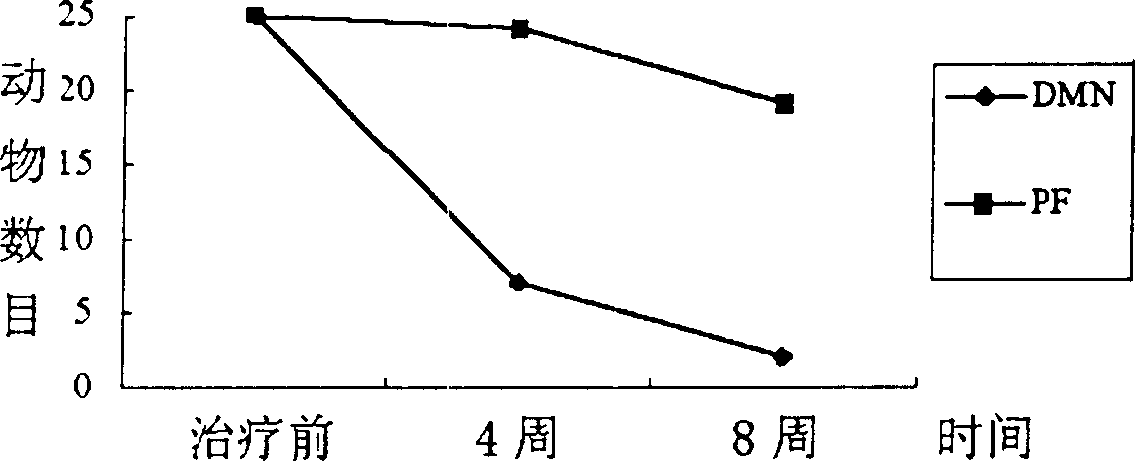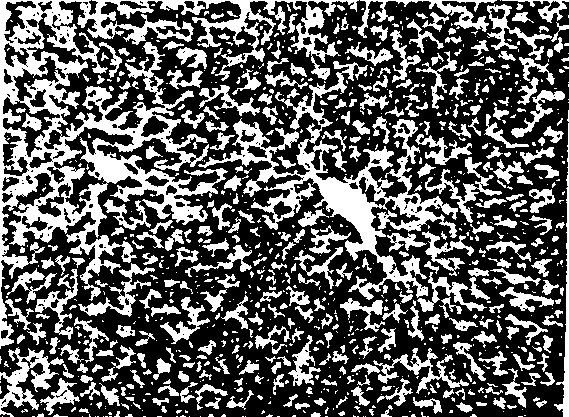Usage of pirfenidone for treating hepatic injury and necrosis and acute lung injury
A technology of acute lung injury and pirfenidone, applied in the field of treatment of liver injury necrosis and acute lung injury, pirfenidone, can solve the problem of reducing mortality
- Summary
- Abstract
- Description
- Claims
- Application Information
AI Technical Summary
Problems solved by technology
Method used
Image
Examples
Embodiment 1
[0064] Mortality in rats with DMN-induced liver injury decreased after pirfenidone treatment
[0065] DMN (Dimethylformamide, Dimethylformamide) is a common chemical substance that causes liver damage, manifested as toxic liver disease, and severe cases lead to acute necrotizing hepatitis, with a dire prognosis.
[0066] Injury hepatitis model in rats was induced by DMN, and the method was as follows: intraperitoneal injection of 1% DMN, 10 mg / Kg, twice a week, continuously for 4 or 8 weeks.
[0067] From the 0th day of model establishment, pirfenidone was administered orally, at a dose of 250 mg / Kg, for 4 or 8 consecutive weeks. The body weight and mortality of the rats were observed.
[0068] The results showed that DMN treatment could cause weight loss and death in rats. After administration of pirfenidone, the body weight can be kept normal, and the mortality rate of animals can be significantly reduced, which is significantly different from that of the control group. (...
Embodiment 2
[0070] Pirfenidone in anti-hepatitis pharmacodynamic animal models
[0071] The experimental method is the same as above. The blood of the experimental animals was taken to separate the serum, and the AST (aspartate aminotransferase) and ALT (alanine aminotransferase) were measured; the liver tissue was taken for pathological examination.
[0072] result:
[0073] At the 4th week of the experiment, hepatic necrosis, hemorrhage, collagen deposition, and perisinus fibrosis were evident in the model group; at 8 weeks, fibrosis was formed after the necrosis of the central venous pericytes, inflammatory cell infiltration in local lesions, and new hemorrhage outwards and large pieces of necrosis ( figure 2 , 3 ). The lesion degree of the pirfenidone treatment group was significantly reduced compared with the model group, a small amount of collagen deposition after necrosis was occasionally seen around the central vein, the necrosis and inflammation of the central vein area were...
Embodiment 3
[0076] Significant effect of pirfenidone on acute lung injury
[0077] In this example, the study on the therapeutic effect of pirfenidone was carried out in rat animal models of lung injury caused by bleomycin and acute lung injury caused by fibrosis and oleic acid. It was found that pirfenidone had a significant effect on experimental lung injury in rats induced by bleomycin and oleic acid. Daily oral administration of 25mg / kg pirfenidone to rats can significantly reduce lung inflammation and relieve lung injury.
[0078] animal model
[0079] Bleomycin (B) model: long-term use of bleomycin can lead to pulmonary fibrosis. Early alveolar wall Cap permeability increases, alveolar and interstitial edema, forming interstitial lungs, and then alveolar and interstitial cellulose exudates, hyaline membrane forms, alveolar atypical hyperplasia and distal epithelial cell squamous metaplasia , the advanced stage shows extensive fibrosis of the alveoli and interstitium, so it is wid...
PUM
 Login to View More
Login to View More Abstract
Description
Claims
Application Information
 Login to View More
Login to View More - R&D
- Intellectual Property
- Life Sciences
- Materials
- Tech Scout
- Unparalleled Data Quality
- Higher Quality Content
- 60% Fewer Hallucinations
Browse by: Latest US Patents, China's latest patents, Technical Efficacy Thesaurus, Application Domain, Technology Topic, Popular Technical Reports.
© 2025 PatSnap. All rights reserved.Legal|Privacy policy|Modern Slavery Act Transparency Statement|Sitemap|About US| Contact US: help@patsnap.com



